Everything you need to know about peonies

Peonies are perennial plants that can grow in one place for decades. The large, fragrant flowers of the plant leave no one indifferent. The richness of the coloring of the buds, ease of care and the ability to winter make this culture the best in the design of flower beds. The green foliage gives the peonies an additional decorative effect.
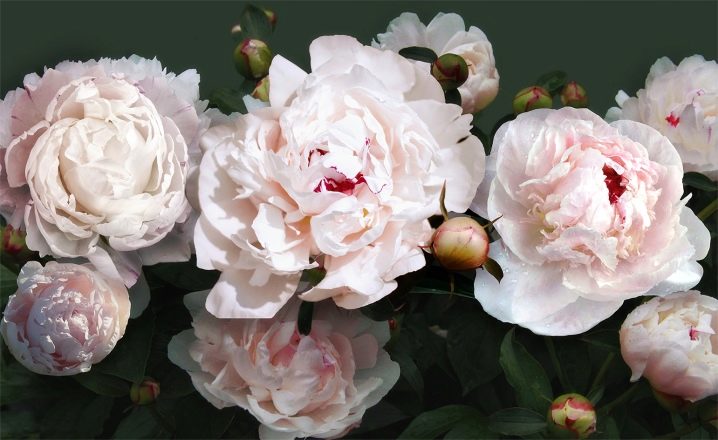
What it is?
Peony is a herbaceous perennial that includes approximately 50 plant species. Culture grows in Europe, northern Africa, East Asia, America. Wild bushes are found in the Caucasus, Ukraine, the Far East, Siberia and the Crimea. The plant is named after the god of Greek mythology - Peony. The culture was used as a medicinal plant in the 1st century AD. NS. On the territory of Russia, flowers were grown in pharmaceutical plots, over time, the plant began to be brought from abroad as an ornamental culture. According to biological, morphological characteristics, the plant is divided into 2 types:
- herbaceous;
- tree-like.


The ground part of the latter becomes stiff over time. The bark is painted in a grayish tone. Shoots are on average 90 cm tall. In herbaceous crops, the aboveground part dies off annually.
According to the structure of the bud, herbaceous peonies are divided into several garden groups:
- simple;
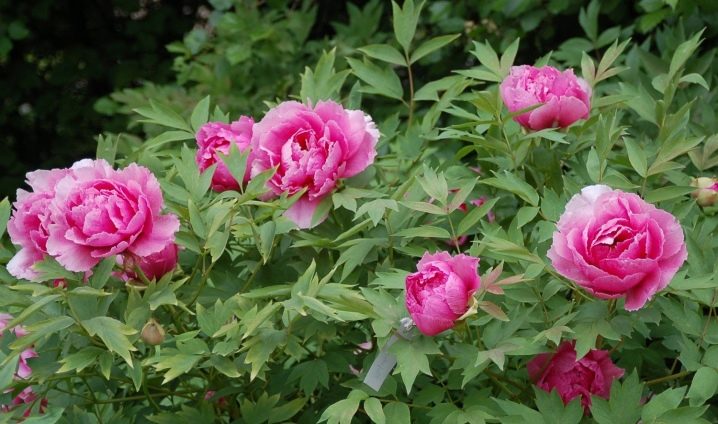
- terry;

- semi-double;

- Japanese;
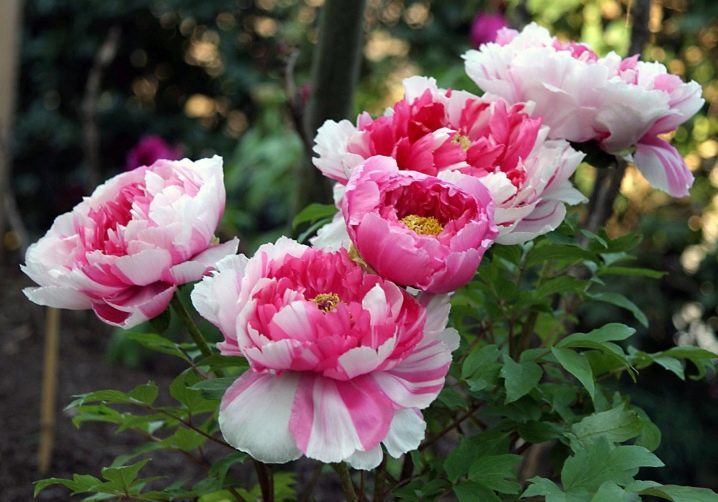
- anemic.
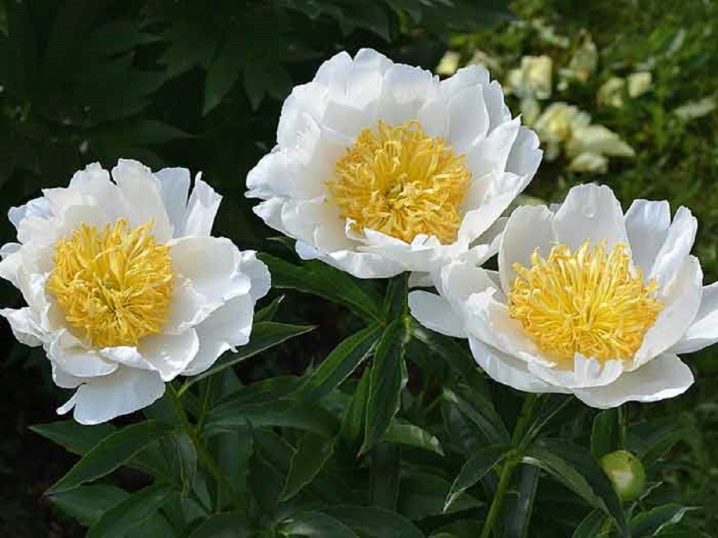
The flowering period is divided into early, medium and late varieties.
- Leaves are pinnate, unpaired or trifoliate. Leaf plates can be painted in all colors of the green gamut, with varying degrees of saturation.
- The rhizome of the culture is developed, large, the roots look like cones.
- The buds are fragrant, located singly, the diameter of the flower reaches 18 cm, they remain fresh for a long time after cutting. Flowering occurs in the spring and summer season.
- Peony seeds are similar to pomegranate seeds, painted in red and purple tones. The seed capsule is round, brown, the surface is covered with thin short hairs.

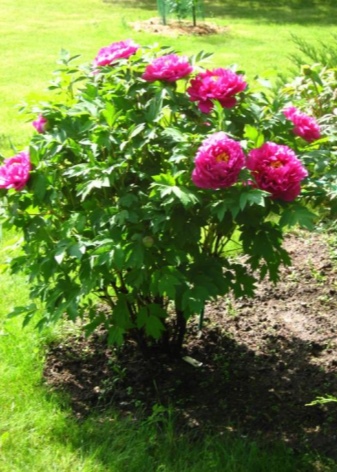
The plant is unpretentious in care, agricultural technology is simple. Even after wilting, the peony bushes do not lose their decorative effect. For the appearance of the culture and its quality, the flower has gained popularity among amateur and professional gardeners. The plant is widely used as a flower for cutting and planting in open ground in crowded places, private plots, botanical gardens.
Types and best varieties
Peony varieties are divided into flowering periods: early tender, medium large and the most beautiful - late. In Russia, due to the long cold weather, the last two groups are most popular. Description of groups and varieties of peonies according to flowering dates.

Early
Herbaceous crops in countries with mild climates bloom in early summer.
- "Adolphe Russo". Peony with simple buds. The flower petals are colored fuchsia, a rich shade with a reddish tint. The opened bud is 12 cm across. The core is covered with golden stamens. The bush is high, reaching one and a half meters. The foliage has a pleasant green warm shade.
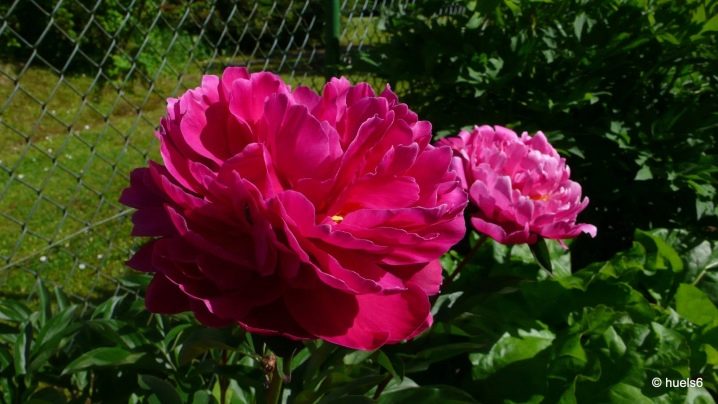
- Le Xin. Densely double peonies, painted white with a creamy pink tint. The edges of the petals are wavy. Inflorescences are large, up to 13 cm in diameter. The leaves are dark green, slightly glossy. The bush is low, the height of an adult plant is no more than 80 cm.
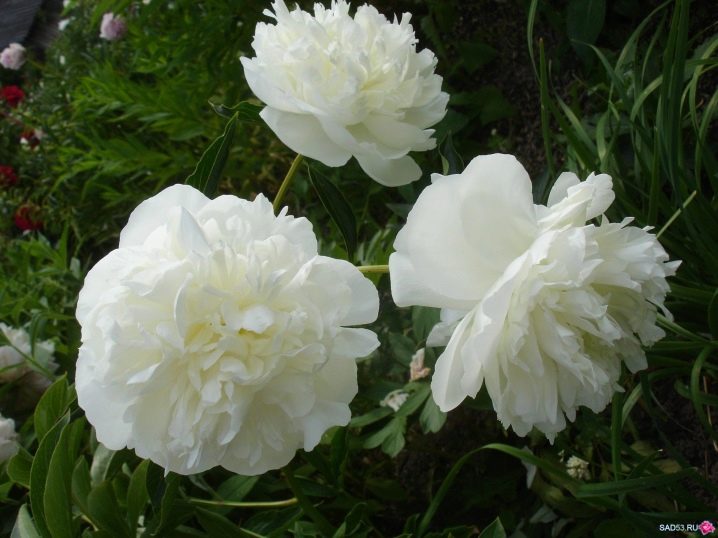
- "Edulis Superba". Variety with bright pink buds with a light border, corrugated edges of the petals, double flowers, fragrant. The buds are about 10 cm in diameter. The bush is medium-high - 120 cm. The leaf plates are dark green, large.
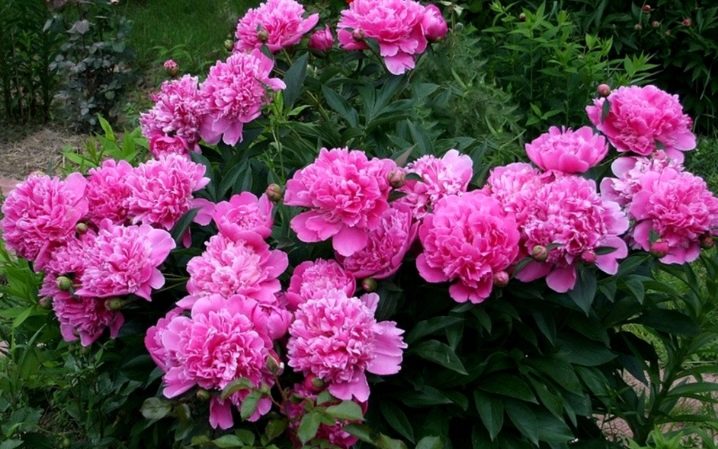
- Dr. H. Barnsby. Double pink buds, shade close to fuchsia. The main feature of the variety: twisting the lower petals of the peony inward, due to which the middle of the bud is obtained in the shape of a sphere. The plant is tall, the flowers are large - up to 12 cm. A profusely flowering variety.
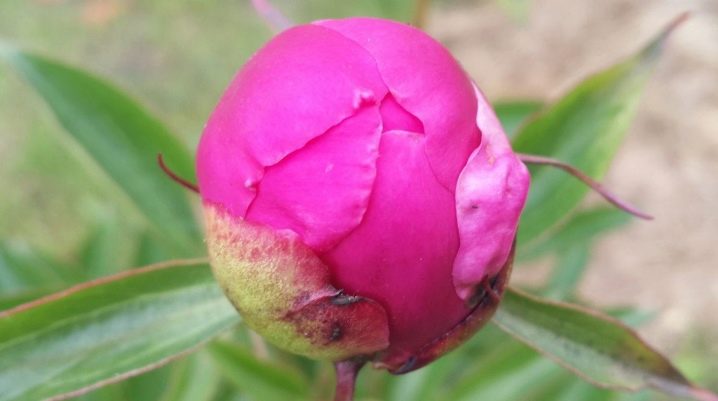
- Festima Maxima. Terry variety with large snow-white cupped flowers, with a pinkish middle. The petals are corrugated, thin. The aroma of the buds is mediocre. The foliage is dark green.

- "Ballerina". Hybrid variety from America. Medium-tall plant with large double buds of a snow-white color, the core is painted in a creamy tone. In the early stages of flowering, the buds have an even creamy color. The leaf plates are wide, short, green in color.
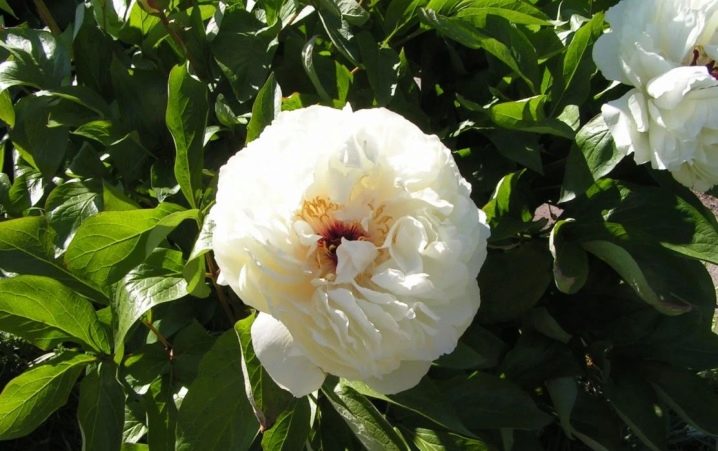
- Louis Choice. A hybrid variety with an unusual color. Terry inflorescences, pink-peach shade with a lemon core, spherical buds, petals resemble chrysanthemum in shape. The diameter of the flower is 17 cm. The foliage is lush, leafy plates with pronounced veins.

Medium varieties
This group includes plants blooming in the second half of June.
- "Bayadere". Culture with clean white dense double buds. The flowers are huge, up to 14 cm in diameter, fragrant. The height of the plant is 120 cm. The foliage is green, with a silvery sheen, the leaf plates are glossy.
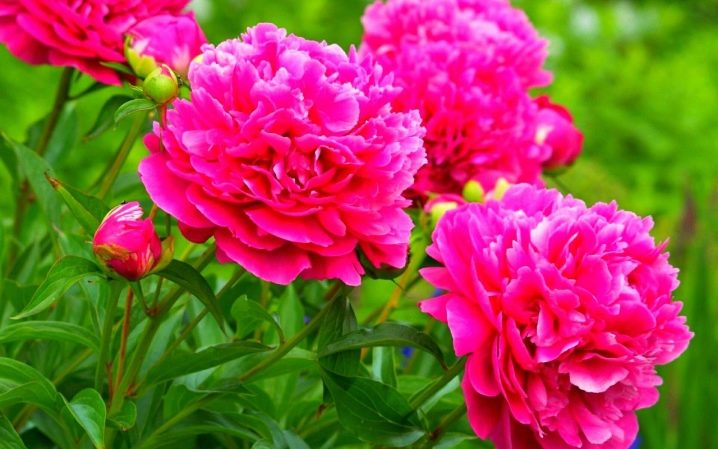
- Longfells. A dwarf bush (maximum height 90 cm) with large buds painted in a rich raspberry color with a red tint. Terry flowers, slightly wavy edges with light edging.
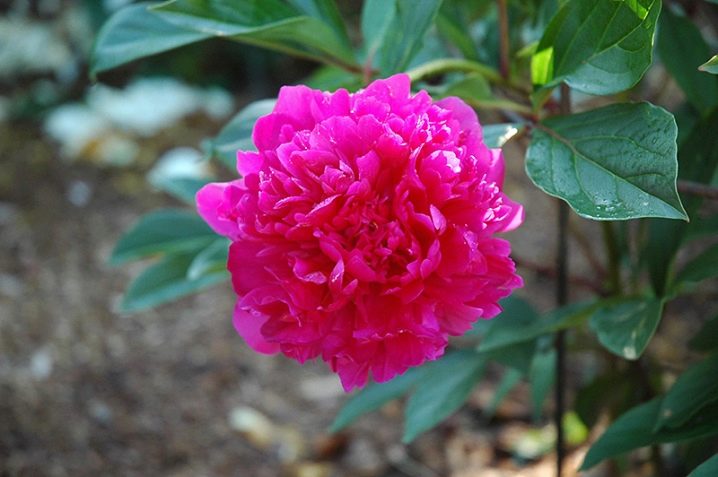
- "Germaine Bigot". Terry variety with flowers of a pale pink tone, the edge of the wavy petals turns into a white-pink hue. The buds are large, up to 12 cm. The bush is low, abundantly flowering. The foliage is dark green, pleasant.
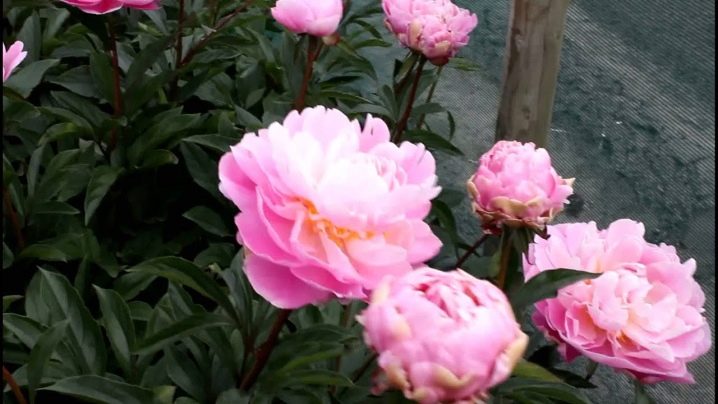
- "Arkady Gaidar". The plant forms double buds of rich fuchsia color. The buds are collected in inflorescences, up to 3 flowers on one shoot. The foliage is green, smooth. This variety is suitable for growing cut flowers.
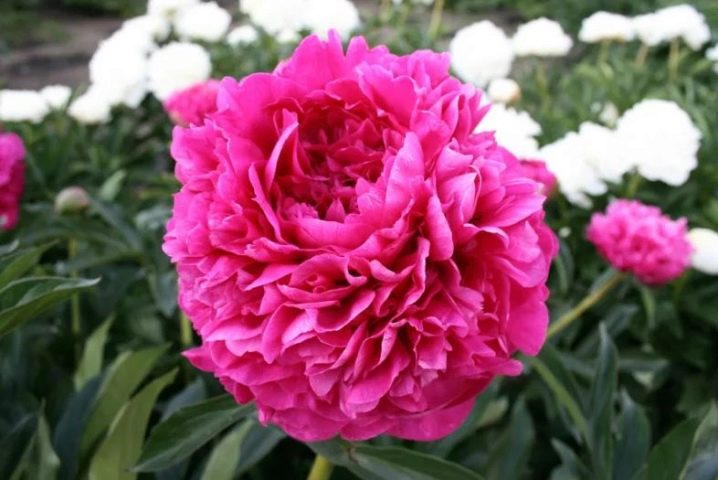
- "Princess Margaret". Medium tall shrub with light green foliage. Leaves are long, narrow, collapsible. The flowers are dark pink at first, brighten as they ripen, have a double structure. The buds are huge, the blossoming flowers are 20 cm in diameter.
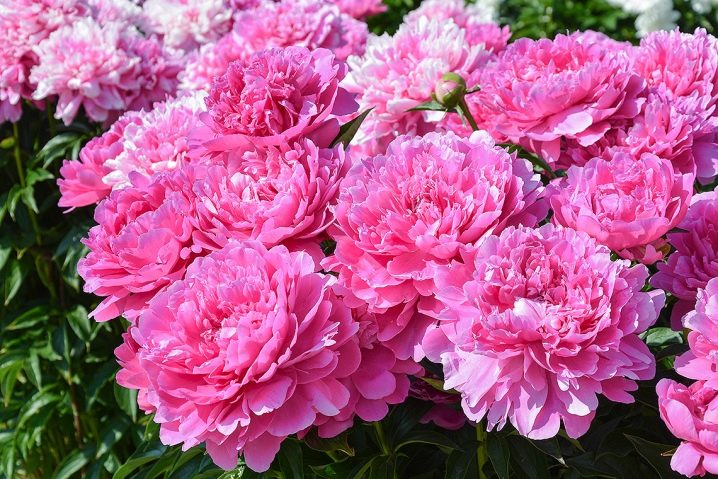
- Blanche Queen. Herbaceous tall culture (90cm) with unusual flowers. The bud is terry white, the center is painted in a white tone with pinkish splashes, followed by petals of a yellowish-lemon shade; the last petals along the edge are white again. The foliage is glossy, dark green.
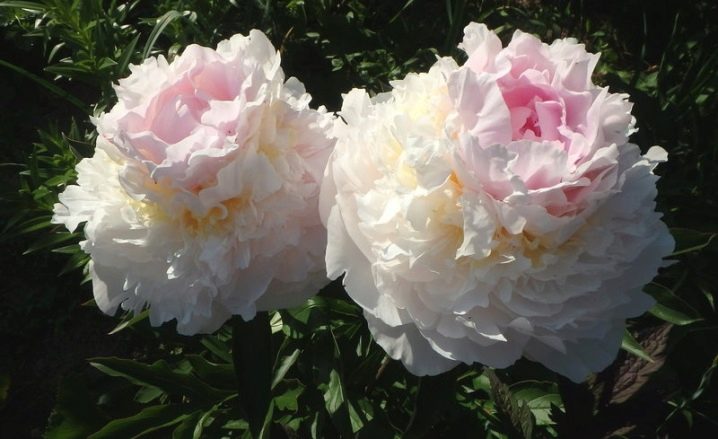
- "Petite Porcelain". Perennial medium grade. Milky buds, semi-double, fragrant. Corrugated petals. Abundantly flowering. Up to 2 flowers develop on the shoots. The foliage is dark green, lush.

Late varieties
The culture blooms in late summer (July-August).
- Anshantress. A plant with unique, densely doubled, creamy buds with a warm yellowish tint. The culture is medium in height. The flowers are huge, shaped like a ball. Leaves are glossy, emerald green.
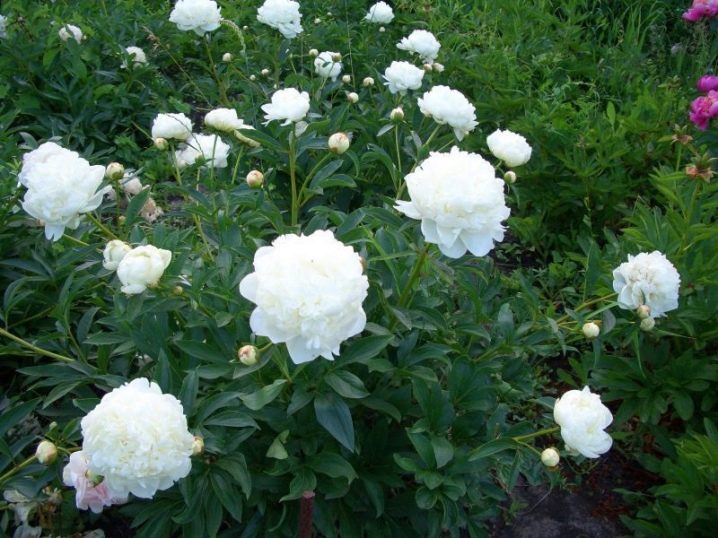
- Marchelle McMahon. Another kind of pink peonies. The buds of the variety are pink-red, large, reaching 12 cm in diameter. The petals are slightly wavy, curling into a tube. The height of the culture is average, up to 100 cm.
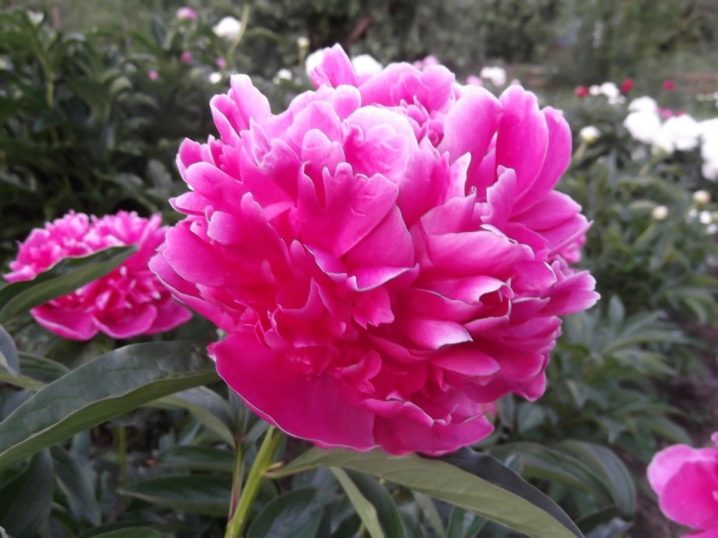
- Sarah Bernhardt. Terry buds of the most delicate pink tone, corrugated petals at the ends are painted in white shades. The flowers are large, drooping under their own weight. The foliage is green with a blue tint, the leaf plates are wide, slightly dull.

- "Nancy Nora". Medium-tall bush with large inflorescences. Flowers of pastel pink range, 18 cm in diameter, double, have a pleasant aroma. The leaf plates are dark green, slightly dull.Stems are straight, strong.
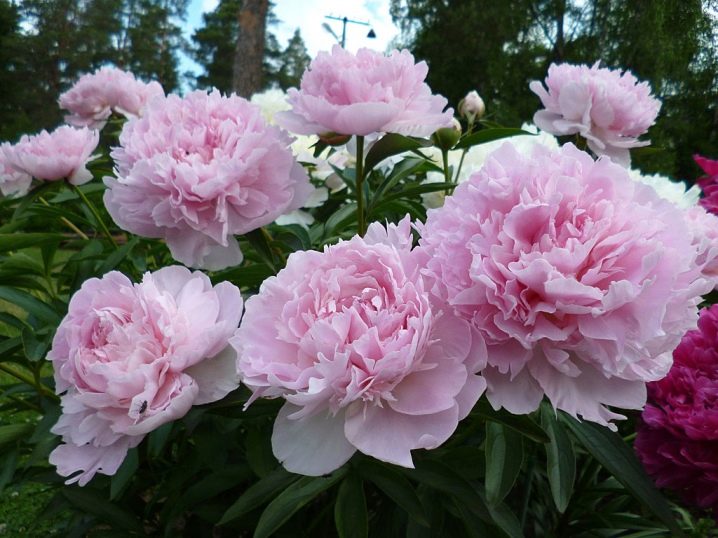
Indoor peonies
Indoor peonies belong to the patio group. Plants are compact, stunted (30 cm), small buds, with a pleasant aroma. The color of the buds is varied: from snow-white to burgundy. The buds are double, simple and semi-double. Popular varieties of indoor varieties.
- Rome - the plant belongs to medium-sized varieties, the buds are pink, double. Abundantly flowering bush, compact, lush. Leaves are narrow, short, light green.
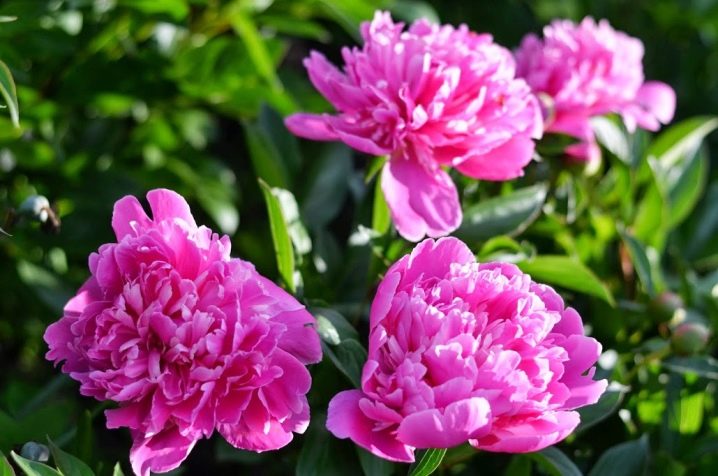
- Oslo - the buds are simple, crimson tone. Early flowering culture.
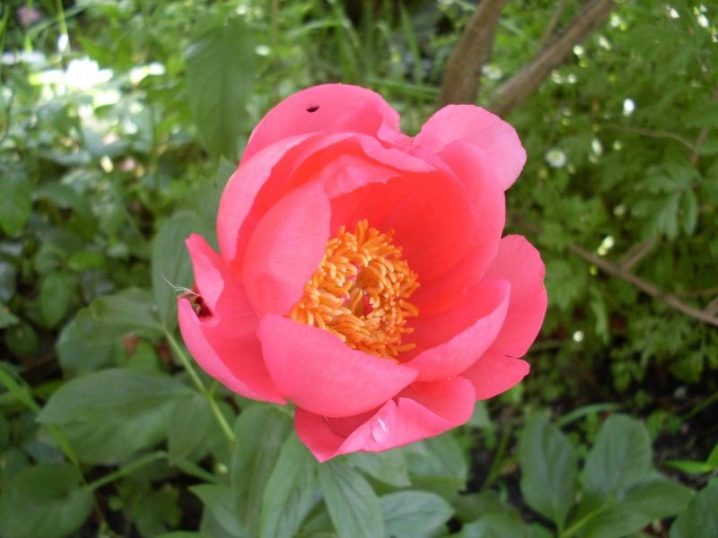
- Moscow - belongs to the middle grades. Semi-double flowers, reddish tone.
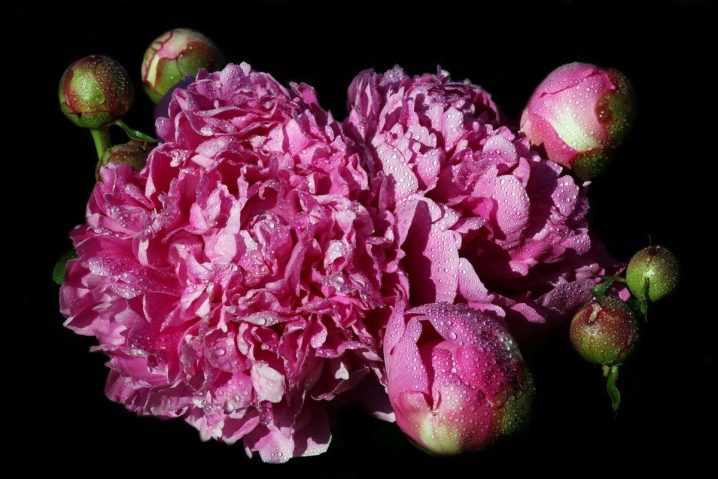
- London - Terry buds, pink-burgundy scale. The foliage is green, dense, the stems are straight. Abundantly flowering bush.
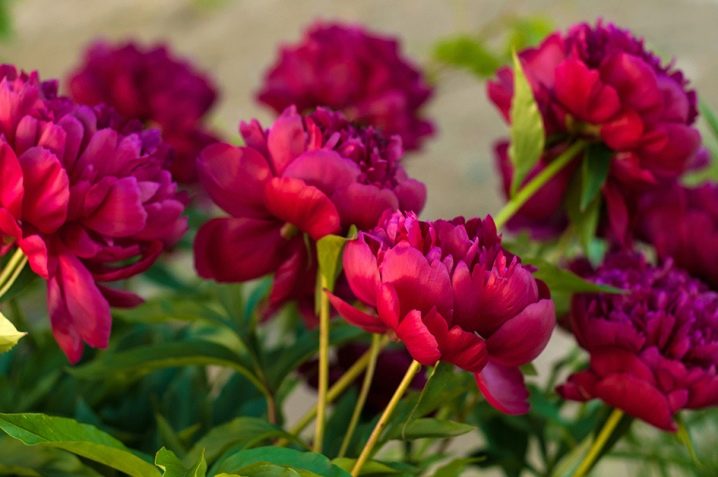
Landing rules
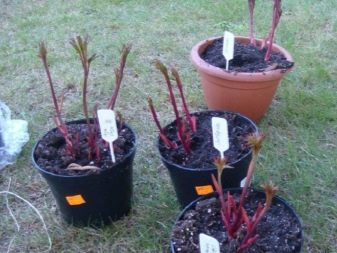

Seedlings are placed in planting pits dug to a depth of 60 cm. Humus is spread on the bottom of the hole. Proportions: 2 parts of soil to 1 part of humus. Bone meal, superphosphates are introduced into the soil mixture.
It is worth filling the planting holes in advance so that the substrate has time to settle, otherwise, if the soil is too loose, the root collar of the culture will be exposed, forming a small depression, which will be filled with water during irrigation and precipitation. Long-term exposure of the plant's vulnerable spot in the liquid will lead to decay of the flower. The best time to plant peonies in the country or in the garden is the end of August, the beginning of autumn. At this time, the division of the bushes is also carried out. Planting in early spring is carried out before the formation of new roots. Peonies are planted at a distance of 1 meter from each other. The rhizomes are placed in the planting pit without tamping, filling it with a substrate so as to close all the voids between the rhizome.
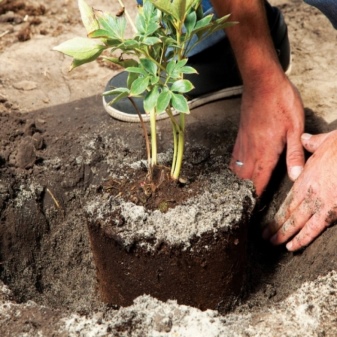

After all the manipulations, the plant is watered abundantly. When the earth subsides, soil is poured into the pits until everything is equal. The reason for the lack of flowering lies in the planting too deep. In this case, foliage builds up, and the plant does not lay flower buds. Flowers, which were divided during transplantation in the spring, lag behind in development. If the plant has not been subject to division, then the culture is transplanted by the transshipment method, while maintaining a clod of earth on the roots. This method is suitable for any season.


After transplanting the plant in the autumn season, the peony must be covered with spruce branches, covered with peat or fallen dry leaves, so that the plant overwinters successfully. In the spring, the shelter is removed.
Subtleties of care
Crop care consists of regular weeding of the topsoil around the bushes, removing weeds.
- With a thickened planting and overgrowing of planting holes with other plants, peonies stop blooming, develop poorly, and the buds become smaller.
- Plants are watered at least once a week, during budding, flowering and in the hot season of the crop, it is necessary to water three buckets of water per plant.
- To obtain large buds for cutting, lateral inflorescences should be pinned. Ornamental bushes are not touched. Faded buds are removed, showered petals and dry foliage are removed.
- In the summer-autumn season, the plant should be carefully looked after.During this period, cultures can get sick with fungal and viral diseases: gray rot, verticillosis, and so on.
- Peonies must be cut, keeping the developed buds, 2 cm away from them.
- In winter, the plants are covered. Straw is not recommended.
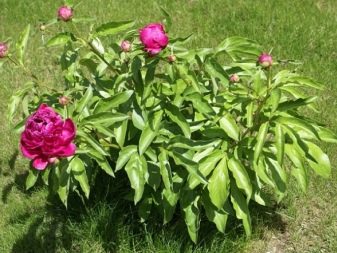
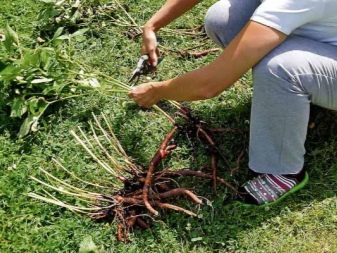
Fertilizing young plants
In the first years of life, young peonies do not require root fertilization with mineral preparations. Peonies bloom profusely in the third year after planting. By this time, the culture is growing 10-15 shoots. At this time, from the period of active growth to the end of autumn, root fertilizing with mineral preparations is carried out. Often there are at least three fertilizers. It is worth feeding the plants according to the scheme of three dressings:
- The first fertilization occurs with nitrogen-containing mixtures and falls on the active vegetative period in early spring, after the snow melts.
- The second procedure is during the laying of flower buds. Used phosphorus-potassium preparations containing a small amount of nitrogen.
- The third - after flowering, exclusively with phosphorus preparations. The last top dressing is the most important, it will ensure the wintering of the culture, the laying of flower ovaries for the next year. Feeding takes place two weeks after the last bud falls.
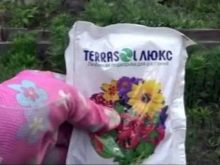
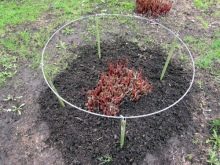
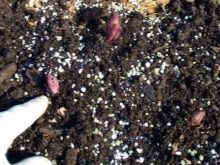
Foliar dressing is carried out by spraying the foliage of the plant with diluted means. It is better to perform procedures in the morning or in the evening. Important! For the qualitative development of the root system of peonies, it is recommended to remove the buds in the first years after planting.
Fertilizing adult plants (8-10 years old)
As a fertilizer, granular (dry) and liquid substances, organic matter are used. Plants respond well to slurry. Mullein is diluted with water in a ratio of 1: 10 or bird droppings are used (1: 20). The diluted mixture should be infused for at least three days. Before watering, superphosphates are added to the liquid and diluted with water 1: 2. Peonies are watered with this fertilizer 1 time during the formation of flower ovaries. The mixture is poured into shallow grooves dug near the bush at a distance of 25 cm from the center of the plant. One bucket of diluted solution is consumed per bush. In the spring, after the snow melts, adult plants are fertilized with decomposed humus, superphosphate, and potassium chloride. The finished mixture is laid out around the peony bushes at a depth of 5 cm.


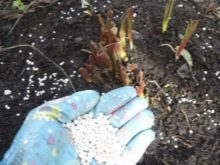
Important! Top dressing should not touch the rhizome of the plant, otherwise chemical burns will occur, which can lead to the death of the plant and make the culture vulnerable to disease.
Reproduction methods
The plant is propagated by seeds, dividing the bush, layering, cuttings. For the first option, only wild crops are suitable. The flowering period for seedlings begins at 4 years. Hybrid varieties of peonies are propagated by seed to obtain new varieties of plants. Seedlings bloom for 6 years and do not retain varietal characteristics. Terry varieties practically do not produce seeds, some varieties do not set seed pods. For such crops, the vegetative propagation method is suitable. Vegetative reproduction:
- dividing the bush;
- stem cuttings;
- use of layering;
- application of root cuttings with buds.

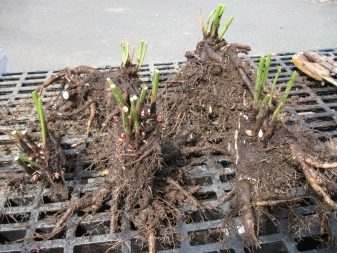
Dividing the bush
The method is suitable for 3 year old plants and older. Old crops are more often exposed to the development of various diseases, the rhizome bears underdeveloped buds in its central part, which makes the plant unsuitable for division. Peony bushes are separated in late summer, early autumn. During this period, the root system is formed, new buds are formed without filamentous light roots. The culture is dug in with grooves to a depth equal to the length of the working blade of the shovel. With the help of a crowbar, shovel or other tool, the peony bush is swayed and uprooted with a clod of earth. The soil is shaken off from the roots and the rhizome is washed with water. Next, the root part of the plant is covered with a woven material and the flower is left in the shade for a couple of hours.The stems of the bush are trimmed two-thirds, leaving shoots 10 cm long.
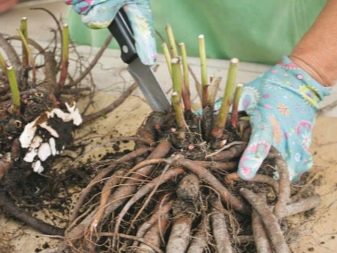

The finished bush is carefully examined, a stake is hammered into a place with a small number of buds, with which the plant can be easily divided into two parts. There should be 4-6 buds for each half of the bush. The root system is fragile, the process of dividing the bush must be done carefully. With a sterile instrument, the half of the bush is divided into small parts. On average, about 10 plots will be released. Deformed, old, infected and rotten roots are stripped down to healthy tissue. Small roots must be preserved and try not to injure. To heal the sections, crushed activated carbon or healing preparations based on tree resin are used. After division, the roots should be disinfected with a solution of formalin or copper sulfate. In order for the plots to take root well, they should be dipped in a clay mash with the addition of growth stimulants (Kornevin, Heteroauxin).
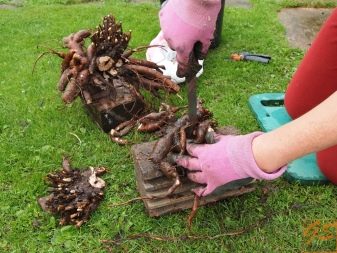
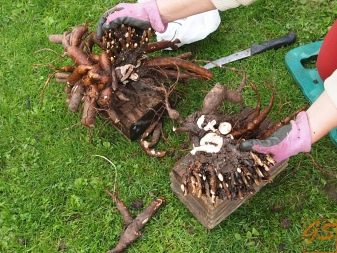
Layers
In this way, only mature bushes aged 5 years or more are propagated. To do this, you need to press the shoots to the ground and secure the branch with a metal bracket, pegs. Sprinkle the lash with a nutritious loose substrate, at least 10 centimeters thick. As it grows, the stem is covered with earth and further, and it is also fixed with pegs. In September, the shoot with the formed roots is cut off. The stem is dipped in a clay mash with the addition of manure, copper sulfate. Further, the layering is placed in a school, the earth is mulched with peat, humus. The plant is covered with winter material.
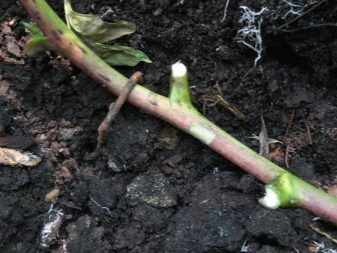
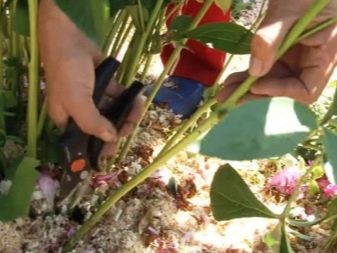
Stem cuttings
Propagation by cuttings taken from the stem is rarely practiced. The method is laborious, most of the cuttings do not take root. Cuttings are cut from the middle part of the shoot, each should have 2 internodes. Fragments are prepared during the budding period, one week before the buds open. Rooting of the material takes place in a greenhouse. 2-3 cuttings are obtained from one shoot. An adult bush yields up to 25 fragments. The finished cut material is kept in a solution of heteroauxin for a day, then the elements are planted in separate containers in a greenhouse. Planting depth - up to 4 cm. The wig maintains a high humidity of 95%, the temperature is stable, around 23 degrees Celsius.
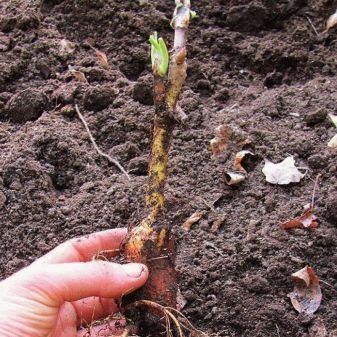

In favorable conditions, the cuttings take root after a month and a half, and a bud forms in the leaf axil. Rooted fragments overwinter in a greenhouse. With the onset of frost, the cuttings are sprinkled with peat 6 cm thick. For growing, the fragments are planted on the ridge next spring. The roots of the culture are dense, rich in nutrient reserves. White roots growing on the rhizome die off annually. These roots are involved in the absorption of moisture from the soil, mineral salts. Growing cuttings lasts up to 2 years.
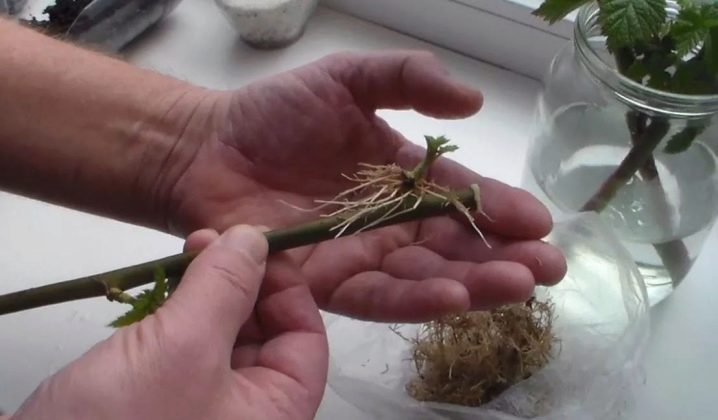
Rhizome cuttings with buds
The method is used in the summer season, in July, after the complete flowering. With a clean tool, ripe shoots with formed buds are cut and removed, with the capture of a part of the root. The stalk is shortened, up to 2 sheets are left. The bud is soaked for 14 hours in a solution of heteroauxin, then the fragment is planted in a school, in a darkened, the depth of the fossa is up to 10 cm. In the middle of autumn, the shoot is removed, the rooted bud is covered with foliage or other material for wintering.
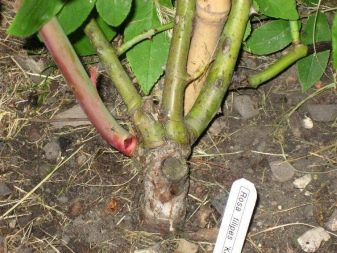

Diseases and pests
Peonies rarely get sick, but with weak immunity, due to mechanical and other effects, the bushes are susceptible to the development of fungal, viral diseases. Insect pests feed on parts of the plant: aphids, bronze beetle, nematodes, ants, and hop worms. Insects feed on the intercellular sap of the culture, soft parts of the plant: petals, stamens, flower roots. The greatest danger is posed by aphids and nematodes, the negative impact of which can lead to the death of a peony.Ants, beetles and other pests lead to a decrease in the decorative effect of the bush, problems of budding.
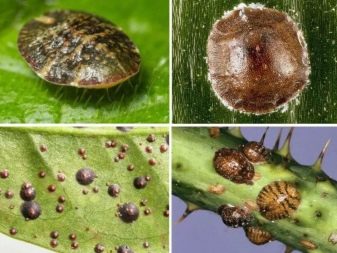

To combat insects, insecticidal preparations of a wide spectrum are used in case of mass infection of crops. At the first sign of infection, it is enough to rinse the plants with soapy water. It is also recommended to replace the topsoil to get rid of insect larvae. Periodic weeding of the soil, removal of plant parts during thickened plantings minimizes the risk of infection.
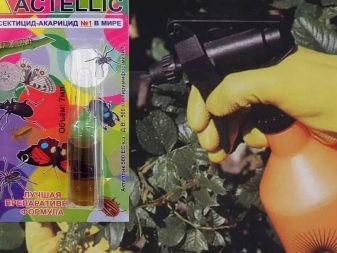
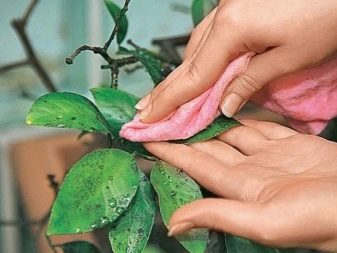
Another problem that growers face is fungal and viral infections. The latter are dangerous because there are no methods of treatment. All a gardener can do is remove the affected plant parts or the entire flower, then burn the infected plant and disinfect the pit.
Viral infections are manifested by blurred spots on leaf plates of various shades (ring mosaic) or by the formation of seals in the tissues of the culture, which are noticeable when the shoots are cut (Lemoine's disease). Fungal infections most often affect the outer side of the leaf plate, forming various colored plaques that contain fungal spores.
- Gray rot can spread to the soil and infect the rhizome of the crop. This disease develops with lightning speed and kills the flower in 3 days.
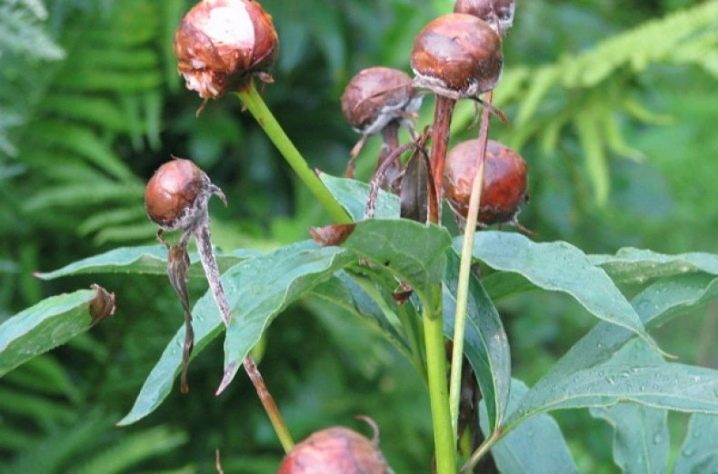
- Rust covers peony leaves with swells of a burgundy, brick shade. As the disease progresses, the spots merge together, the leaf plate looks withered, turns yellow, dries up and dies off. The processes of photosynthesis are disrupted, the plant dies over time.
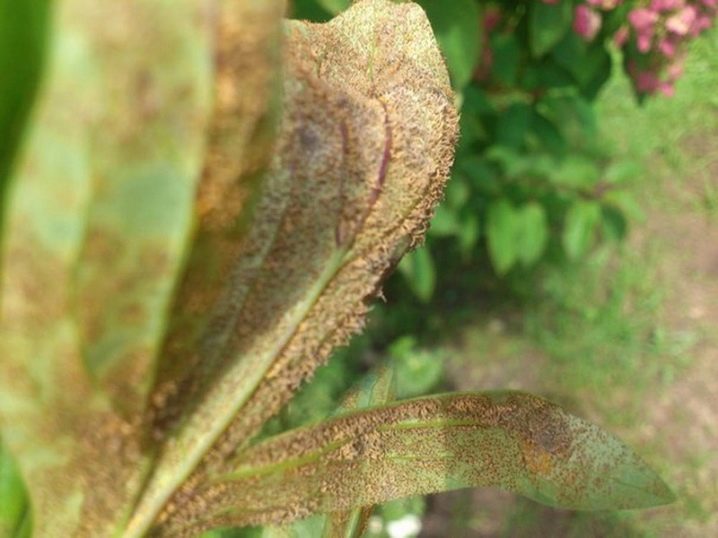
- Cladosporium, septoria and phyllostictosis affect crop tops and buds. They are noticeable in the spring and summer season. The soft tissues of the plant are covered with spots of dark and light shades. If untreated, the spots grow, forming necrotic foci, the leaf plates dry up, fall off, the affected areas burst, releasing spores. Fungi easily tolerate a dormant period.
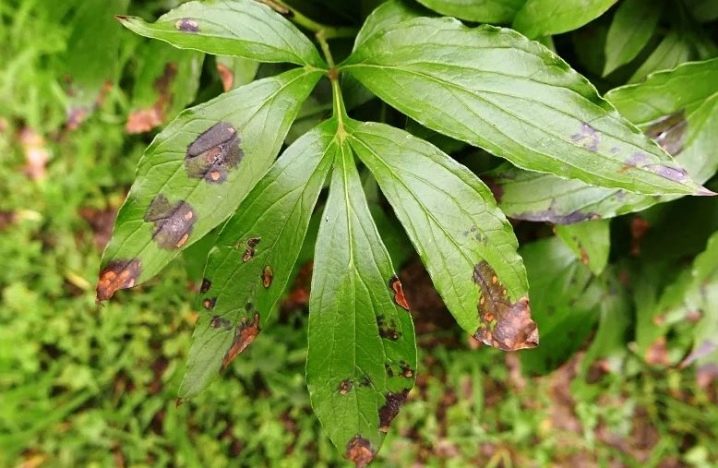
- Powdery mildew - the most harmless fungal disease. Peony leaf plates are covered with a fluffy light bloom. The disease develops slowly, at first it is enough to wipe the entire plant with soapy water or use a decoction of dandelions several times a week, with mandatory repetition on the following days.
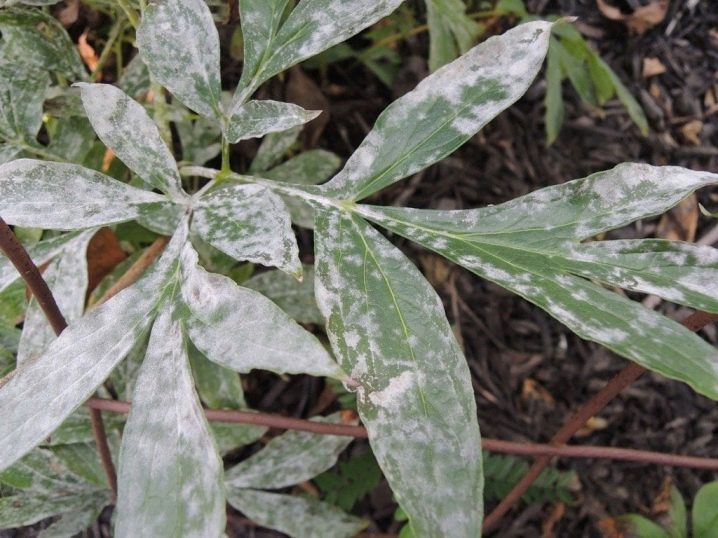
- Root rot occurs on swampy, waterlogged soils. Plants of open ground, pot crops are affected. Treatment is reduced to a complete replacement of the substrate, control of watering and removal of affected roots.
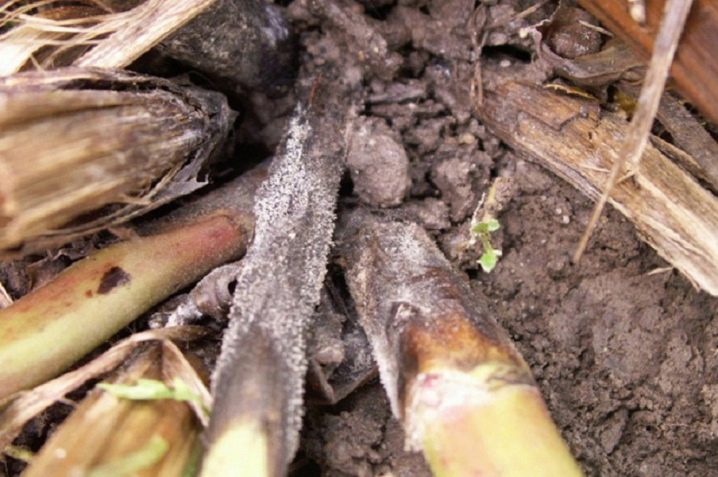
When working with infected peony bushes, it is necessary to disinfect all tools, hands and clothes so as not to transfer fungal spores to healthy plants. The bushes are treated with direct-acting fungicidal preparations for two weeks according to the instructions. The affected parts of the plant are cleaned to healthy tissues, the infected tops are burned. Wounds are covered with resin or charcoal. If possible, it is advisable to isolate any diseased plant from other crops.
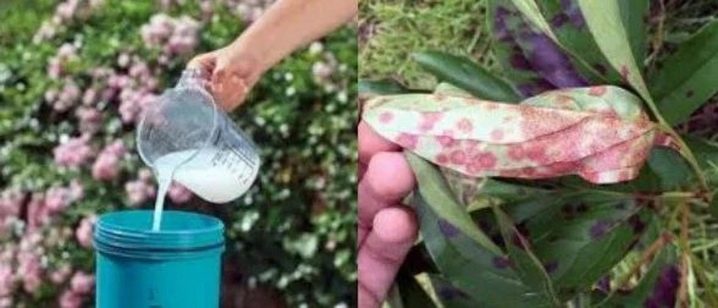
Site design options
Peonies are planted in group and single plantings, combining color combinations, crop growth. Single plantings are represented by bushes from the same variety, fenced off with a wooden fence so that the stems of the plant do not spread along the ground, while maintaining the splendor of the bush.

Light flowers are combined with plants of the same gamut or saturation, dark-colored crops are planted among decorative deciduous plants to enhance the shade of the buds.
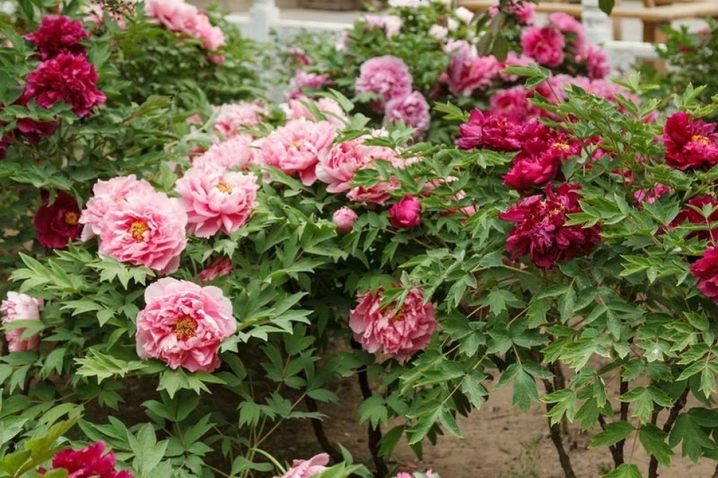
Large tall bushes are best placed in an open bare area, and dwarf crops look great as a curb, fence composition, framing the walls of the house. You can also plant them in tall flowerpots, wrap flowers around arches and other mesh structures.
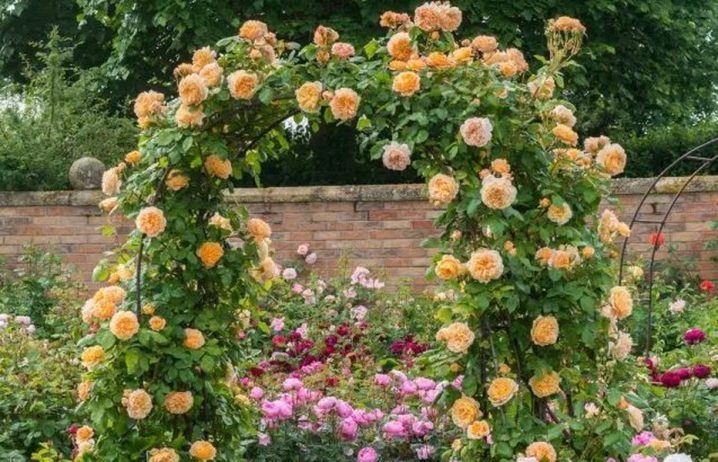
For information on how to properly care for peonies, see the next video.







































































































Thank you, great site! Everything about flowers - complete, accessible, colorful! Received all the information I was interested in.
A very useful site. For florists, all information in one place. There are a lot of practical tips about plants. Simply invaluable information.
The comment was sent successfully.